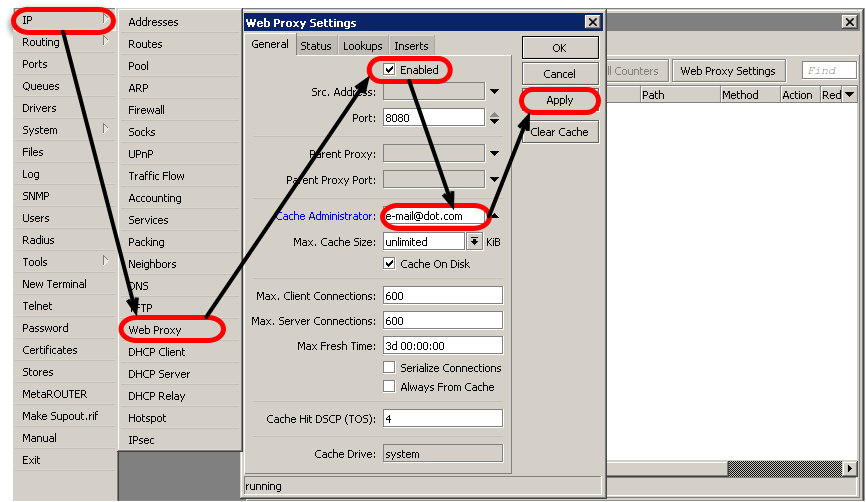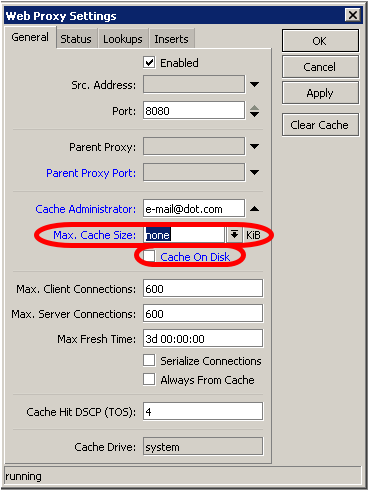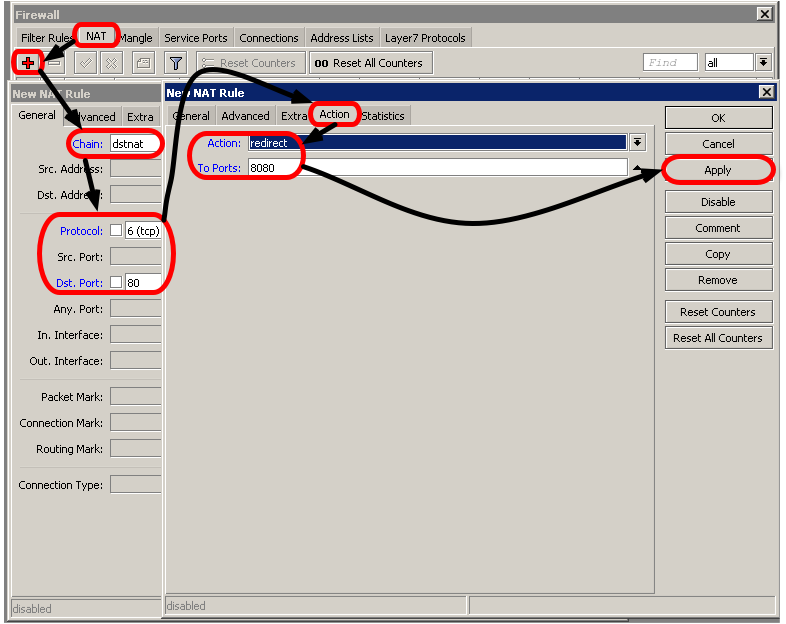Proxy on RouterBOARD's external drive: Difference between revisions
→Example: Add small example |
|||
| Line 24: | Line 24: | ||
[[Image:proxy10.png]] | [[Image:proxy10.png]] | ||
* Set cache to RAM by '''Cache On Disk=no''' option. '''Max. Cache Size=none''' forces proxy not to | * Set cache to be saved to RAM by '''Cache On Disk=no''' option. '''Max. Cache Size=none''' forces proxy not to cache any files, other values for '''Max. Cache Size''' enables proxy caching to disk or RAM, | ||
[[Image:Proxy11.png]] | [[Image:Proxy11.png]] | ||
Proxy is enabled at this point | Proxy is enabled at this point. Additional configuration is necessary for the clients browser, proxy address should be added to configuration settings on the client computer. Add NAT redirect rule to avoid mass configuration of clients browser, redirect rule will forward all clients to the proxy. | ||
[[Image:Proxy14.png]] | |||
== Proxy with external drive == | == Proxy with external drive == | ||
Revision as of 14:27, 27 May 2009
Description
MikroTik RouterOS proxy implements different features of HTTP caching and filtering. RouterBOARD can be used to implement HTTP caching on your network. RouterBOARD uses NAND as hard drive, external drive is more recommended due to space limitation 64/128/512 MB, when HTTP caching is necessary on your network.
External drive on RouterBOARD
The list of the RouterBOARDs, where is the option to add external drive;
- RouterBOARD 5xx (532/532A - Compact Flash card slot);
- RouterBOARD 4xx (433AH - MicroSD card slot; 433UAH - MicroSD card slot; 450G - MicroSD card slot; 493AH - MicroSD card slot)
- RouterBOARD 6xx (600/600a - Compact Flash card slot);
- RouterBOARD 1000 (1000 - Compact Flash card slot);
Example
MikroTik RouterOS proxy can be used in three modes, a) cache is not saved anywhere; b) cache is saved to RAM; c) cache is save to Hard Drive. When RouterBOARD does not have external drive, it is advised to use a) or b) method. c) is used with the RouterBOARDs, which have external drives.
Proxy without external drive
Let's look on the proxy example, when RouterBOARD does not have external drive, proxy cache is saved to RAM or not saved anywhere.
- Enable proxy and specify information about yourself,
- Set cache to be saved to RAM by Cache On Disk=no option. Max. Cache Size=none forces proxy not to cache any files, other values for Max. Cache Size enables proxy caching to disk or RAM,
Proxy is enabled at this point. Additional configuration is necessary for the clients browser, proxy address should be added to configuration settings on the client computer. Add NAT redirect rule to avoid mass configuration of clients browser, redirect rule will forward all clients to the proxy.


